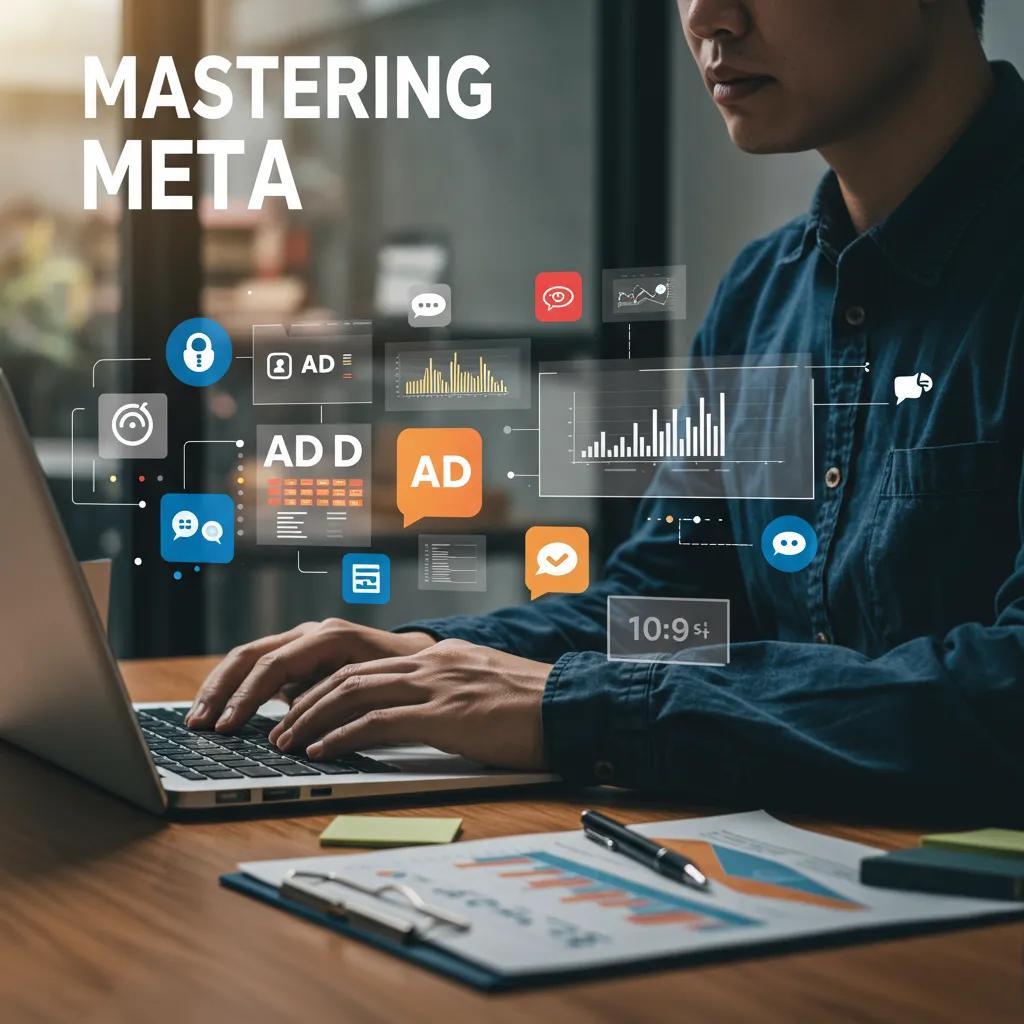Mastering META (Facebook) Advertising: How to Create, Optimize, and Measure Effective Meta Ads Campaigns

Imagine reaching over three billion active users with precision and measurable impact—Meta Ads Manager makes it possible. In this guide you’ll discover how to set up your Facebook ad account, target the ideal audience, craft compelling creative, manage budgets effectively, and measure performance with advanced analytics.
You’ll learn how to leverage Meta Ads Manager’s core features, build granular demographic and behavioral segments, optimize diverse ad formats, and apply AI-driven strategies to maximize ROI.
We’ll explore budgeting models, bidding strategies, and conversion tracking via Facebook Pixel, then dive into full-funnel tactics like dynamic product ads and cross-platform campaigns. By the end, you’ll have a clear roadmap for mastering paid ads digital marketing on Facebook and Instagram—all aligned to featured-snippet optimization and semantic best practices.
What Is Meta Ads Manager and How Do You Set Up Your Facebook Ad Account?
Meta Ads Manager is a unified dashboard for creating, managing, and optimizing Facebook and Instagram ad campaigns. It orchestrates campaign structure—campaigns, ad sets, ads—to align objectives, targeting, placements, and budgets into a coherent workflow that drives measurable business results.
What Are the Core Features of Meta Ads Manager?
Meta Ads Manager provides campaign objective selection, audience insights, placement controls, budget and schedule settings, performance reporting, and creative testing tools. It integrates with Facebook Pixel for conversion tracking and offers automated rules for real-time optimization.
How to Create Your First Facebook Ad Campaign in Meta Ads Manager?
Open Meta Ads Manager and click “Create.”
Choose a campaign objective such as Traffic or Conversions.
Define your audience using demographics, interests, or custom segments.
Select ad placements across Facebook, Instagram, Messenger, or Audience Network.
Set your budget and schedule, then build your ad creative and launch.
What Are the Different Campaign Objectives in Meta Ads?
Campaign objectives fall into Awareness, Consideration, and Conversion categories:
Brand Awareness & Reach
Traffic & Engagement
App Installs & Video Views
Lead Generation & Messages
Conversions & Catalog Sales
How Does Meta Business Suite Support Your Advertising Efforts?
Meta Business Suite centralizes page management, organic post scheduling, and ad creation, syncing directly with Ads Manager. It streamlines cross-platform publishing, insights analysis, and collaboration across teams, enhancing operational efficiency.
How Do You Target the Right Audience with Meta Ads?

Precise audience targeting in Meta Ads combines demographic, interest, behavioral, and first-party data segments to reach users most likely to convert. Granular segmentation enables efficient spend allocation and higher relevance scores for improved ad performance.
What Is Demographic Targeting on Facebook and Instagram?
Demographic targeting uses attributes such as age, gender, location, language, education, and life events to narrow down users based on profile information. It ensures ads are shown to people who match your ideal customer persona.
How to Use Interest-Based and Behavioral Targeting in Meta Ads?
Interest-based targeting leverages pages liked and content interacted with on Meta platforms, while behavioral targeting capitalizes on past purchase behavior, device usage, and travel patterns to refine reach.
How Do You Create and Use Custom Audiences for Facebook Ads?
Custom Audiences are built from customer lists, website visitors tracked by Facebook Pixel, or app activity, enabling advertisers to re-engage known contacts with tailored messaging.
What Are Lookalike Audiences and How Do They Expand Your Reach?
Lookalike Audiences derive from a seed Custom Audience to find new users with similar characteristics, scaling reach without sacrificing relevance or performance efficiency.
How to Analyze and Avoid Audience Overlap in Meta Campaigns?
Audience overlap diagnostics identify segments that share users, allowing you to exclude overlapping groups and reduce bidding competition within your own account.
What Are the Best Meta Ad Formats and How Do You Optimize Ad Creative?
Meta Ads support image, video, carousel, and collection formats to match campaign objectives and audience preferences. Optimized creative enhances engagement, click-through rates, and conversions by aligning format, messaging, and design principles.
What Are the Differences Between Image, Video, Carousel, and Collection Ads?
Image ads use single visuals for clear messaging, video ads engage with motion and sound, carousel ads showcase up to ten cards for multiple products, and collection ads pair videos or images with a product grid for immersive mobile experiences.
How to Create Engaging Video Ads for Facebook and Instagram?
Capture attention in the first three seconds, use captions for silent viewing, maintain brand presence throughout, and optimize aspect ratios for each placement—Feed, Stories, or Reels.
How Do Carousel Ads Help Showcase Multiple Products?
Carousel ads enable sequential storytelling or multi-product displays within a single ad unit, improving interaction rates by inviting swipes and showcasing diverse offerings.
What Are Collection Ads and Instant Experiences?
Collection ads open into Instant Experiences—full-screen mobile experiences combining video, images, and product catalogs that immerse users and streamline the path from discovery to checkout.

How to Craft Compelling Ad Copy and Visual Storytelling for Meta Ads?
Use clear benefit-driven headlines, short descriptions, strong calls-to-action, cohesive color palettes, and high-quality imagery to create narratives that align with audience interests and campaign objectives.
How Much Do Facebook and Instagram Ads Cost and How Do You Budget Effectively?
Meta Ads costs vary by industry, audience, and ad quality, with key metrics including cost per click (CPC), cost per mille (CPM), and cost per acquisition (CPA). An informed budgeting strategy optimizes spend for maximum ROI.
What Are the Key Facebook Advertising Cost Metrics: CPC, CPM, and CPA?
CPC measures cost per link click, CPM reflects cost per thousand impressions, and CPA calculates cost per desired action such as a purchase or lead submission—each guiding budget allocation.
How to Set and Manage Your Meta Ads Budget?
Allocate daily or lifetime budgets by campaign objective, monitor performance, adjust pacing through automated rules, and reallocate funds toward highest-performing segments.
What Are the Different Bidding Strategies in Meta Ads?
Bidding options include Lowest Cost to maximize results, Bid Cap to control maximum bid, Cost Cap to limit average CPA, and Target Cost to stabilize costs at desired levels.
How to Optimize Your Ad Spend for Maximum ROI?
Regularly review performance data, pause underperforming ads, increase budgets on high-ROI audiences, test new creative variations, and employ automated bid strategies.
How Do You Measure and Optimize Meta Ads Performance?
Accurate performance measurement relies on integration of Facebook Pixel, UTM parameters, and in-platform reporting to track key metrics and inform ongoing optimization cycles.
How to Implement Facebook Pixel for Conversion Tracking?
Install the Pixel code snippet on your website or through tag manager, configure standard and custom events, verify data via Pixel Helper, and use event data to optimize ad delivery.
What Are the Key Performance Indicators (KPIs) for Meta Ads?
Critical KPIs include click-through rate (CTR), cost per click (CPC), cost per acquisition (CPA), conversion rate (CVR), return on ad spend (ROAS), and relevance score.
How to Conduct A/B Testing for Facebook Ad Campaigns?
Test one variable at a time—creative, copy, audience, or placement—run both variants simultaneously, measure statistical significance, and iterate based on results.
How to Analyze Meta Ads Reports to Improve Campaign Results?
Use breakdowns by age, gender, placement, and device; compare metrics across segments; identify trends; and apply insights to refine targeting and creative.
What Are Best Practices for Conversion Rate Optimization (CRO) on Landing Pages?
Ensure landing pages load quickly, deliver consistent messaging from ad to page, feature clear calls-to-action, and use A/B testing to refine headlines, layouts, and forms.
What Advanced Meta Advertising Techniques Can Boost Your Campaigns?
Advanced Meta Ads strategies leverage retargeting, dynamic creative, AI optimization, and full-funnel orchestration to maximize engagement and revenue across customer journeys.
How to Use Retargeting and Remarketing Strategies on Meta Platforms?
Segment website visitors by behavior, serve sequential messages at key funnel stages, and combine dynamic ads with lookalike expansion to re-engage warm audiences.
What Are Dynamic Product Ads and How to Set Them Up?
Dynamic Product Ads automatically pull product details and images from your catalog to serve personalized ad units based on users’ past interactions with your inventory.
How Is AI Integrated into Meta Ads for Smarter Optimization?
Meta’s automated tools use machine learning to optimize delivery for conversions, select optimal placements, and generate dynamic creative variations that adapt to audience preferences.
What Is a Full-Funnel Meta Advertising Strategy?
A full-funnel approach aligns top-of-funnel brand awareness with mid-funnel engagement tactics and bottom-of-funnel conversion campaigns, using tailored messaging and measurement at each stage.
How to Run Cross-Platform Meta Ads on Facebook, Instagram, and Messenger?
Use unified campaigns, select “Automatic Placements,” tailor creative dimensions for each channel, and monitor attribution across touchpoints to allocate budget effectively.
What Are Common Questions About META (Facebook) Advertising?
How Do I Start a Facebook Ad Campaign?
Open Meta Ads Manager, select an objective, define your audience, choose placements, set budget and schedule, design your ad, and launch.
What Are the Best Strategies for Facebook Ads in 2025?
Focus on short-form video formats like Reels, prioritize first-party data for Custom Audiences, leverage AI-driven creative testing, and optimize for privacy-compliant retargeting.
How Much Do Facebook Ads Cost on Average?
Average CPC hovers around $1.38, CPM approximately $4.29, and CPA about $19.68 across industries, though rates vary by audience and ad quality.
Are Facebook Ads Still Effective in 2025?
Yes, they remain effective for brand reach and direct response when campaigns use data-driven targeting, AI optimization, and immersive formats like video and collection ads.
How Do I Target My Audience Effectively on Facebook Ads?
Combine demographic filters, interest signals, behavioral indicators, Custom Audiences from first-party data, and Lookalike Audiences for precise and scalable targeting.
How Do I Get Started?
We know, it's pretty complicated but don't worry - we handle everything for you! Book a call with our team - let's get the ball rolling 👇
© 2025 Apex Media LLC. All rights reserved.




